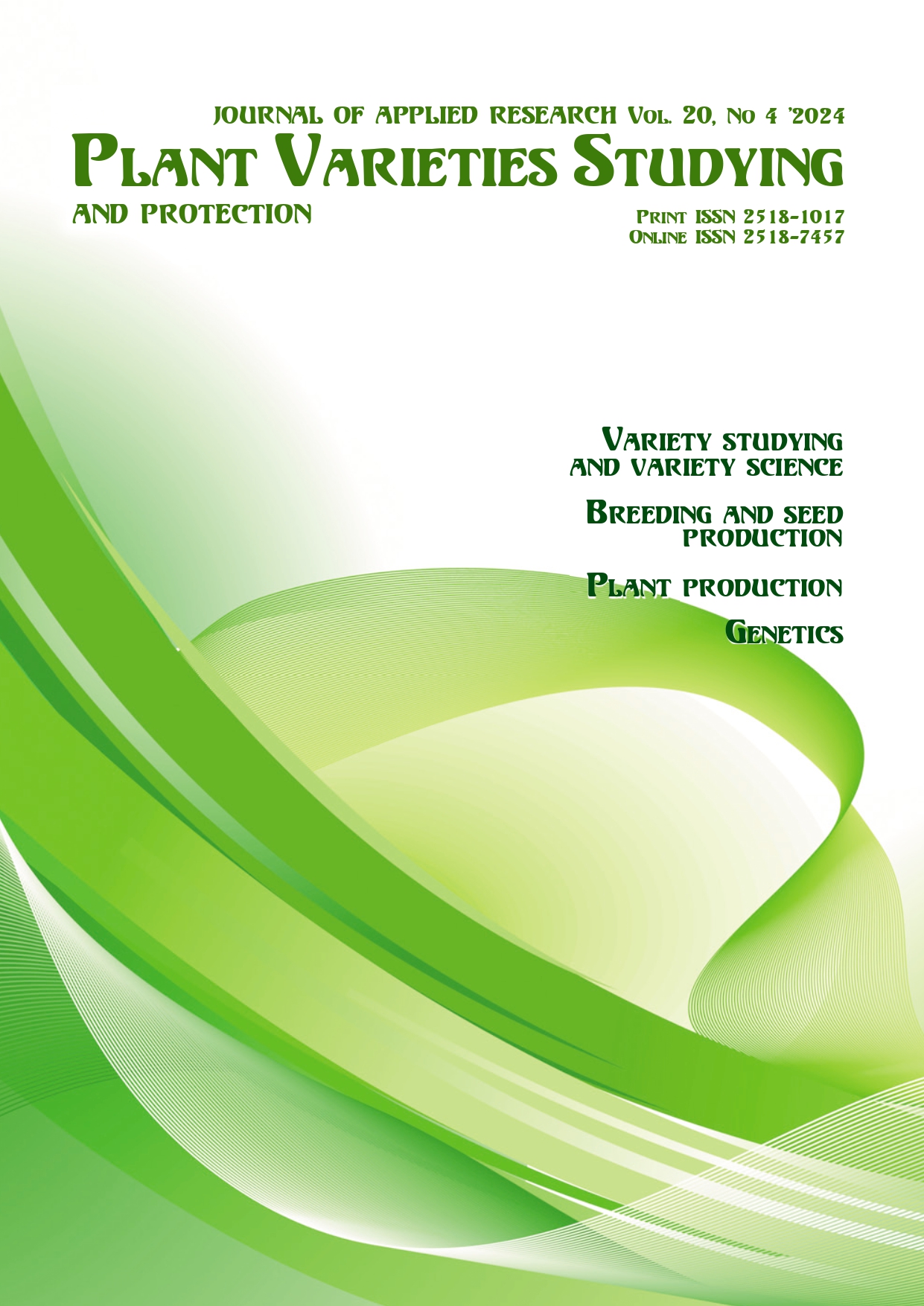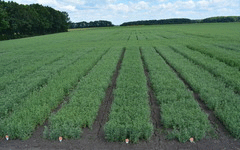Comparative analysis of maize (Zea mays L.) lines based on morphological and molecular characteristics
DOI:
https://doi.org/10.21498/2518-1017.20.4.2024.324206Keywords:
maize, phenotypic and molecular distances, SSR markers, similarity coefficients, correlation, alleleAbstract
Purpose. To determine the phylogenetic relationships between maize lines based on morphological description (DUS test) and SSR markers. Methods. Field studies (descriptive plant morphology), molecular techniques (PCR, capillary electrophoresis), and statistical analyses (correlation analysis, hierarchical clustering). Results. Based on field studies of 57 maize lines by morphological traits, the codes of qualitative and quantitative characteristics were determined, allowing the classification of the studied maize lines into three groups according to their similarity level: distinct, similar, and very similar. Pearson correlation coefficients were used to calculate phenotypic distances between the studied maize lines, resulting in five cluster groups and seven separate clusters formed by individual lines. The most similar maize lines according to the morphological character codes were those with a similarity coefficient of 0.997, which belong to the group of similar lines according to the results of the testing for distinctness, uniformity, and stability (DUS). The similarity coefficients among lines classified as very similar were sufficiently high, ranging from 0.890 to 0.990, although one pair of lines within this group had a similarity coefficient of 0.771. Based on Roger's molecular distances for nine SSR markers, the most similar lines had a similarity coefficient of 0.16, yet this pair was classified as distinct according to DUS testing. The most distinct pair of lines based on SSR markers had a similarity coefficient of 0.42. The correlation analysis between phenotypic and molecular distance matrices revealed a very weak inverse correlation (r = −0.1). Conclusions. It was found that the calculation of phenotypic and molecular distances reflects the level of similarity among the studied genotypes based on morphological traits and SSR markers. It was shown that the degree of similarity among the studied maize lines varies depending on the evaluation approach, as indicated by expert assessment based on DUS testing results.
Downloads
References
Kumar, B., Choudhary, M., Kumar, P., Kumar, K., Kumar, S., Singh, B. K., & Rakshit, S. (2022). Population structure analysis and association mapping for turcicum leaf blight resistance in tropical maize using SSR markers. Genes, 13(4), Article 618. doi: 10.3390/genes13040618
 |
| 
Afriyie-Debrah, C., Addo, J. S., Berchie, J. N., Nyandanu, D., & Ribeiro, P. F. (2018). DNA-based markers as the DUS descriptors to assess the genetic diversity in the maize varieties. Asian Journal of Biotechnology and Bioresource Technology, 4(1), 1–9. doi: 10.9734/AJB2T/2018/41367
The Cabinet of Ministers of Ukraine. (2024). State Statistics Service of Ukraine (the data are valid as of December, 15, 2024). Kyiv. Retrieved from https://www.ukrstat.gov.ua [in Ukrainian]
Bocianowski, J., Nowosad, K., Wróbel, B., & Szulc, P. (2021). Identification of associations between SSR markers and quantitative traits of maize (Zea mays L.). Agronomy, 11(1), Article 182. doi: 10.3390/agronomy11010182

Yang, C. J., Russell, J., Ramsay, L., Thomas, W., Powell, W., & Mackay, I. (2021). Overcoming barriers to the registration of new plant varieties under the DUS system. Communications Biology, 4(1), Article 302. doi: 10.1038/s42003-021-01840-9
 |
| 
Achard, F., Butruille, M., Madjarac, S., Nelson, P. T., Duesing, J., Laffont, J. L., ... Smith, J. S. C. (2020). Single nucleotide polymorphisms facilitate distinctness‐uniformity‐stability testing of soybean cultivars for plant variety protection. Crop Science, 60(5), 2280–2303. doi: 10.1002/csc2.20201

Jamali, S. H., Cockram, J., & Hickey, L. T. (2019). Insights into deployment of DNA markers in plant variety protection and registration. Theoretical and Applied Genetics, 132(7), 1911–1929. doi: 10.1007/s00122-019-03348-7
 |
| 
Yu, J. K., & Chung, Y. S. (2021). Plant variety protection: Current practices and insights. Genes, 12(8), Article 1127. doi: 10.3390/genes12081127
 |
| 
Kyi, S., Win, K. K., Than, H., Win, S., Htwe, N., & Hlaing, A. (2022). DNA fingerprinting of selected maize (Zea mays L.) genotypes using SSR markers. Environmental and Rural Development, 13, 158–163.
Dandan, D. O. U., Jianjun, S. U. N., Yuxi, G. U. O., Dexin, W. A. N. G., Xinhai, G. U. O., & Chaoming, D. I. N. G. (2023). Genetic diversity and population structure analyses of maize inbred lines based on DUS test traits in Huang‐Huai‐Hai region. Journal of Henan Agricultural Sciences, 52(5), 24–32. doi: 10.15933/j.cnki.1004-3268.2023.05.004
Choudhary, M., Singh, A., Das, M. M., Kumar, P., Naliath, R., Singh, V., ... Rakshit, S. (2023). Morpho-physiological traits and SSR markers-based analysis of relationships and genetic diversity among fodder maize landraces in India. Molecular Biology Reports, 50(8), 6829–6841. doi: 10.1007/s11033-023-08602-2
 |
| 
Ministry of Agrarian Policy and Food of Ukraine. (2024). Register of plant varieties suitable for distribution in Ukraine (the register is valid as of December 21, 2024). Kyiv. Retrieved from https://minagro.gov.ua/file-storage/reyestr-sortiv-roslin [In Ukrainian]
Gupta, N. (2019). DNA extraction and polymerase chain reaction. Journal of Cytology, 36(2), 116–117. doi: 10.4103/JOC.JOC_110_18
 |
| 
Seeds of agricultural crops. Methods for determining quality: State Standard of Ukraine 4138:2002. (2003). Kyiv: Derzhspozhyvstandart Ukrainy. [In Ukrainian]
International Organization for Standardization. (2015). Molecular biomarker analysis – SSR analysis of maize (E): ISO/TR 17623:2015. Geneva.
Ukrainian Institute for Plant Variety Examination. (2021). Methodology for the examination of maize (Zea mays L.) varieties for distinctness, uniformity, and stability. Kyiv. Retrieved from https://sops.gov.ua/uploads/page/metodiki/2021-08-13-zernovy.pdf [In Ukrainian]
Xia, X. (2018). DAMBE7: New and improved tools for data analysis in molecular biology and evolution. Molecular Biology and Evolution, 35(6), 1550–1552. doi: 10.1093/molbev/msy073
 |
| 
Prysiazhniuk, L., Starychenko, Y., Hryniv, S., Shytikova, Y., Leshchuk, N., Melnyk, S., & Kliachenko, O. (2021). The comparison analysis of software for Mantel test between DNA markers and morphological traits of plant varieties. AGROFOR, 6(2), 1–12. doi: 10.7251/AGRENG2102132P
Lu, Z., Ma, Z., Fu, M., & Su, J. (2024). Clustering analysis of natural D-borneol resource plants based on simple sequence repeat (SSR) markers, leaf morphology, and chemical composition. Biochemical Genetics, 1–20. doi: 10.1007/s10528-024-10755-z
 |
| 
Adu, G. B., Awuku, F. J., Amegbor, I. K., Haruna, A., Manigben, K. A., & Aboyadana, P. A. (2019). Genetic characterization and population structure of maize populations using SSR markers. Annals of Agricultural Sciences, 64(1), 47–54. doi: 10.1016/j.aoas.2019.05.006

Vasile, V., Ciucă, M., Nicolae, E., Voaideș, C., & Cornea, C. P. (2022). Assessment of genetic similarity and purity degree among several Romanian maize inbred lines using SSR markers. Scientific Bulletin Series F. Biotechnologies, 26(1). Retrieved from https://biotechnologyjournal.usamv.ro/pdf/2022/issue_1/Art2.pdf
Nikolić, A., Kravić, N., Srdić, J., Kovačević, D., Anđelković, V., Filipović, M., & Mladenović-Drinić, S. (2019). Divergence among maize genotypes with different kernel types according to SSR marker analysis. Genetika, 51(1), 237–249. doi: 10.2298/GENSR1901237N

Gunjaca, J., Buhinicek, I., Jukic, M., Sarcevic, H., Vragolovic, A., Kozic, Z., & Pejic, I. (2008). Discriminating maize inbred lines using molecular and DUS data. Euphytica, 1–2, 165–172. doi: 10.1007/s10681-007-9518-z

Kumar, A., Longmei, N., Kumar, P., & Kaushik, P. (2022). Molecular marker analysis of genetic diversity in maize: A review. OBM Genetics, 6(1), 1–19. doi: 10.21926/obm.genet.2201150

Stagnati, L., Soffritti, G., Martino, M., Lanubile, A., Desiderio, F., Ravasio, A., ... Busconi, M. (2021). Morphological and genetic characterization of local maize accessions from Emilia Romagna Region, Italy. Sustainability, 14(1), Article 91. doi: 10.3390/su14010091

Andjelkovic, V., Nikolic, A., Kovacevic, D., Mladenovic-Drinic, S., Kravic, N., Babic, V., ... Bosev, D. (2018). Conserving maize in gene banks: Changes in genetic diversity revealed by morphological and SSR markers. Chilean Journal of Agricultural Research, 78(1), 30–38.

Downloads
Published
How to Cite
Issue
Section
License
Copyright (c) 2024 L. M. Prysiazhniuk, Yu. V. Shytikova, M. M. Tahantsova, I. O. Dikhtiar, S. M. Hryniv

This work is licensed under a Creative Commons Attribution-ShareAlike 4.0 International License.
Starting in 2022, the copyright to the publication remains with the authors
Our journal abides by the CREATIVE COMMONS copyright rights and permissions for open access journals.
Authors, who are published in this journal, agree to the following conditions:
- The authors reserve the right to authorship of the work and pass the first publication right of this work to the journal under the terms of a Creative Commons Attribution License, which allows others to freely distribute the published research with the obligatory reference to the authors of the original work and the first publication of the work in this journal.
- The authors have the right to conclude separate supplement agreements that relate to non-exclusive work distribution in the form in which it has been published by the journal (for example, to upload the work to the online storage of the journal or publish it as part of a monograph), provided that the reference to the first publication of the work in this journal is included.

























 Ukrainian Institute for Plant Varieties Examination
Ukrainian Institute for Plant Varieties Examination  Селекційно-генетичний інститут
Селекційно-генетичний інститут Institute of Plant Physiology and Genetics of the National Academy of Sciences of Ukraine
Institute of Plant Physiology and Genetics of the National Academy of Sciences of Ukraine
 The National Academy of Agrarian Sciences of Ukraine
The National Academy of Agrarian Sciences of Ukraine